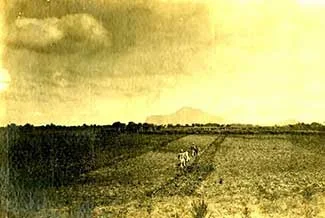Taysan’s Relative Isolation from the Rest of Batangas in 1916
Taysan is one of the province of Batangas’ middle-sized municipalities, with a land area of roughly 9,362 hectares and a population of just over 38 thousand as per the 2015 Philippine Census. The town is completely landlocked, surrounded as it is by the neighboring towns of Ibaan, Rosario and Lobo along with the city of Batangas.
Manuel Sastron’s 1895 publication “Batangas y Su Provincia1” (Batangas and Its Province) listed Taysan as among Batangas’ 22 towns at the time. The municipal status was retained through the short-lived Philippine Republic under Emilio Aguinaldo, when Taysan’s leader went by the title “Capitan Municipal2” (Municipal or Town Captain).
Early during the American colonial era, however, Taysan was sacked by a band of brigands (called “tulisanes”) and was subsequently placed under the jurisdiction of Rosario. As a barrio of the latter, it was given the name Mercedes.
The living conditions in Taysan when it was briefly the barrio of Mercedes were described by one Antoline C. Lualhati3 in an Anthropology paper written in 1916. The paper was actually about marriage customs, not far different from those elsewhere in Batangas already covered in other articles in this web site.
The more interesting part of the paper was the description of life in Mercedes, and why customs had been preserved. The people of the barrio, Lualhati wrote, “were descendants of families that lived and died there. Very, very few of the inhabitants are from other towns.”
People of Mercedes, Lualhati further wrote, were “born, married, lived, multiplied and died in the same place, products of the same conditions, perpetrators of customs, beliefs and superstitions of the locality.”
Why this was so, Lualhati explained, “The place has never offered inducements or attractions which could have encouraged immigration. The place is situated inland and is very far from the seacoast. The people never have the opportunity of eating fresh fish from the sea coast towns of Labao (presumably, Lobo), Batangas and Bawan (Bauan).”
People of Mercedes lived on rice and corn, canned salmon or sardines and pork and eggs presumably from hogs and chickens that they raised themselves. The barrio did not even have a bakery.
There were very few stores in the place; and whatever merchandize was sold in these was brought in by packhorses from the towns of Batangas, Rosario or Lipa. Getting goods into Mercedes was no mean feat because “transportation was poor.”
Moreover, Lualhati wrote in all candor that there was really no need to build roads in the barrio because “there are no native products which could be carried in commerce with considerable profit to the speculator.” What this meant was that Mercedes did not produce goods that would be of enough business value to make the building of roads feasible.
It was, in fact, from this difficulty in getting to Mercedes that the barrio supposedly got the name Taysan or Taisan. According to folklore2, it took so much sacrifice to get to the place because one had to cross many rivers and brooks and travel lonely and hazardous trails. One day, one traveler was supposed to have shouted, “Tiisan! (sacrifice)” and the word stuck until it became Taysan or Taisan.
Lualhati elaborated on this difficulty further, writing that there were as many as six rivers to cross to get to and from Rosario, just four kilometers away; and 10 or 12 rivers on the way to and from Ibaan, which was five or six kilometers away.
During the rainy season, the waters in these rivers and creeks rose, making crossing them perilous. It was because of this that Mercedes or Taisan would become relatively isolated for at least part of each year. Bamboo bridges would later be built to remedy this problem, but these allowed only for pedestrian traffic.
The terrain in Mercedes was flat, wrote Lualhati, which naturally meant that agriculture was the main preoccupation of the barrio’s people. Presumably, this was subsistence farming for the locals to meet their daily needs. There was no lumber, herding and, of course, fishing industry.
“All these things combined,” Lualhati concluded, “are enough to explain why people from neighboring towns are not and could not be led to make a living in this place (Mercedes).” On the other hand, because of this isolation and absence of immigrants, the traditions and customs of the people remained the same “without alterations or additions.”
Not long after Lualhati’s paper was written, inhabitants of the barrio started to lobby for the restoration of its former municipal status. This was granted when a law was passed in 19194 separating Mercedes from Rosario, making it once again the Municipality of Taysan.
2 “Historical Data of the Municipality of Taysan,” online at the National Library of the Philippines Digital Collections.
3 “Former Marriage Customs in Rosario, Batangas Province,” written 1916 by Antoline C. Lualhati, online at the Henry Otley-Beyer Collection of the National Library of the Philippines Digital Collections.
4 “Taysan,” online at DILG-CALABARZON.

